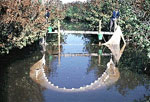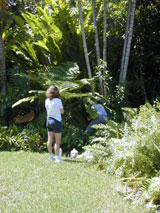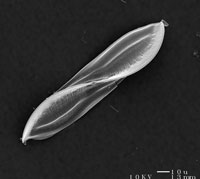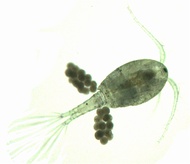Wetlands Ecology
Upon arrival at FMEL in 1979, I developed a basic/applied wetlands ecology program investigating the impacts of human activities on the Indian River Lagoon ecosystem and using research results to devise management strategies to minimize negative impacts and promote positive ones. A major environmental issue at that time was the impounding of more than 40,000 ha. of coastal marshes and mangrove forests for mosquito control. We investigated the ecology and environmental consequences of impounding on a wide variety of estuarine components including mangroves, fish and plankton communities, surface and pore water chemistry, vegetation distribution and production, and seagrass distribution and physiology. As a result of this research, management strategies for coastal wetlands were devised and are widely used today.
 |
 |
 |
Mosquito Biology
Due to my tenure at the FMEL and to active collaborations with FMEL colleagues, I have  also developed an interest in mosquito ecology and control. Since 1998 I have conducted studies that include research on habitat and geographic factors that influence the spatial distribution of several mosquito species that are potential disease vectors (Rey et al. - J. Medical Entomology 43:1134-1141), studies on mosquito production from nutrient rich aquatic systems (Rey et al. - J. AMCA 26:160-166), mosquito production from constructed wetlands (Rey et al. - J. AMCA 22: 198-205) and urban habitats (Rey et al. - J. Vector Ecology 31: 334-343), and others. This part of my research program combines field and laboratory-based studies and the use of geographic information systems to analyze and categorize complex habitat variables and their relationship with the biology of mosquitoes and of their natural enemies. More recently, we have conducted studies on the field biology of mosquitoes that inhabit natural and artificial water holding containers. These include extensive field studies on container habitat use and of oviposition behavior and interactions among container mosquitoes (see "Current Research").
also developed an interest in mosquito ecology and control. Since 1998 I have conducted studies that include research on habitat and geographic factors that influence the spatial distribution of several mosquito species that are potential disease vectors (Rey et al. - J. Medical Entomology 43:1134-1141), studies on mosquito production from nutrient rich aquatic systems (Rey et al. - J. AMCA 26:160-166), mosquito production from constructed wetlands (Rey et al. - J. AMCA 22: 198-205) and urban habitats (Rey et al. - J. Vector Ecology 31: 334-343), and others. This part of my research program combines field and laboratory-based studies and the use of geographic information systems to analyze and categorize complex habitat variables and their relationship with the biology of mosquitoes and of their natural enemies. More recently, we have conducted studies on the field biology of mosquitoes that inhabit natural and artificial water holding containers. These include extensive field studies on container habitat use and of oviposition behavior and interactions among container mosquitoes (see "Current Research").
Biological Control
Worldwide, the use of pesticides has increased more than ten-fold since the 1950s (Driesche and Bellows 1996). Many pesticides have been effective in controlling the target pests, but there are  problems associated with their widespread use including pest control failures, development of resistant insecticide resistance, elimination of populations of beneficial organisms, contamination of the environment, damage to human health, and often very high costs. Although pesticides will be with us for the foreseeable future, an integrated approach to pest management is now considered essential, particularly in view of the challenges facing future generations in terms of human health and the world's food and energy supplies. Biological control is a fundamental part of integrated pest management programs. In the recent past, we have investigated the use of naturally occurring algal products (Rey et al. - Aquatic Ecology 43: 987-997) and naturally occurring copepods (Rey et al.- J. Vector Ecology 28: 124-134) for mosquito control.
problems associated with their widespread use including pest control failures, development of resistant insecticide resistance, elimination of populations of beneficial organisms, contamination of the environment, damage to human health, and often very high costs. Although pesticides will be with us for the foreseeable future, an integrated approach to pest management is now considered essential, particularly in view of the challenges facing future generations in terms of human health and the world's food and energy supplies. Biological control is a fundamental part of integrated pest management programs. In the recent past, we have investigated the use of naturally occurring algal products (Rey et al. - Aquatic Ecology 43: 987-997) and naturally occurring copepods (Rey et al.- J. Vector Ecology 28: 124-134) for mosquito control.
The cyclopoid copepods Macrocyclops albidus and Mesocyclops aspericornis are being tested for biological control of mosquitoes in laboratory microcosms, in controlled field conditions, and in field experiments. These copepod species are promising candidates for control of mosquito larvae because they are widespread and highly effective predators that are capable of establishing and maintaining populations under a wide variety of field conditions. Additionally, these species are relatively easy to culture, maintain, and deliver to the target areas.
culture, maintain, and deliver to the target areas.
Our previous work (Rey et al. J. Vector Ecology 28:124-134) demonstrated that M. albidus was highly efficient in controlling mosquitoes in all three settings, reaching close to 90% reduction in larval survival under field conditions and exceeding the recommended predation rates for effective mosquito control in laboratory experiments. The predator was most effective on 1-4-d-old larvae. Alternate food and habitat structure significantly influenced the predation rates on mosquito larvae. Once established, the copepod was able to maintain reproducing populations in the field for the duration of the experiments. We are currently exploring the effectiveness of these copepods in containers known from our previous studies to be common mosquito producers, in both urban and rural settings (see "Current Research").

